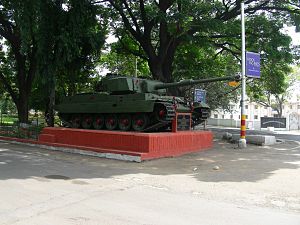| Vijayanta | |
|---|---|
 Vijayanta MBT taken outside the Indian National War Memorial (Maharashtra). | |
| Type | Main Battle Tank |
| Place of origin |
|
| Service history | |
| In service | 1965-2008 |
| Used by |
|
| Wars | Indo-Pakistani War of 1971 |
| Production history | |
| Manufacturer | Vickers-Armstrongs |
| Produced |
1963 (Vickers Mk.I prototype) 1965-1983 (Vijayanta production) |
| No. built | 2200 |
| Specifications | |
| Mass | 39,000 kg (43 short tons) |
| Length | 9.788 m (32.11 ft) |
| Width | 3.168 m (10.39 ft) |
| Height | 2.711 m (8.89 ft) |
| Crew | 4 |
|
| |
| Armour | 80 mm (3.1 in) steel (hull and turret front) |
Main armament |
1 x 105 mm L7A2 (44 rounds) |
Secondary armament |
1 x 12.7 mm MG (ranging gun) (1000 rounds) 1 x 12.7 mm MG (pintle mount) (2000 rounds) 1 x 7.62 mm MG(Co-Ax) (500 rounds) |
| Engine |
Leyland L60 Diesel 535 bhp (399 kW) |
| Transmission | David Brown Ltd. (formerly Self-Changing Gears Ltd.) TN12 semi-automatic gearbox |
| Suspension | Torsion bar |
Operational range | 530 km (330 mi) |
| Maximum speed | 50 km/h (31 mph) |
The Vijayanta (en:"Victorious"[1]) main battle tank was built in India based on a licensed design of the Vickers Mk.1. The prototype was completed in 1963 and the tank entered service in 1965. The first 90 Vehicles were built by Vickers in the UK.[2] Production continued at the Heavy Vehicles Factory in Avadi until 1983 with 2200 being built. A number of the tank hulls were converted to other uses such as self-propelled guns after being withdrawn from service.[3] The Vijayanta has been supplanted by the T-72M1 in Indian service.One of the Tanks is presently kept at Colvin Taluqdars' College Lucknow
Variants[]
- Catapult SPA - Self-propelled artillery. A Russian M-46 field gun was mounted on a lengthened Vijayanta hull in an open-topped armoured box superstructure.[4]
- Kartik AVLB - Armoured vehicle-launched bridge. The same elongated hull used for the Catapult was also used to create the Kartik bridge launching vehicle. The Kartik uses a scissors style bridge of Eastern European design, and was first introduced in 1989.
- Vijayanta ARV - Armoured recovery vehicle based on the Vijayanta hull. The design was optimised to keep the weight within 40 tons to achieve a lifting capacity of 10 tons and pulling capacity of 25 tons. Around 200 numbers them have been purchased by Indian army to replace the obsolete Sherman and Centurion ARVs.
- CEASE - The Canal Embankment ASsault Equipment (CEASE) is a special type of bridging system developed by the Research & Development Establishment (Engineers) (R&DE(Engrs)), Pune. It is suitable for high bank canals up to 4.5m. as encountered in India's western borders. As of 1998 user assisted technical evaluation of the system has been completed successfully. Six tracked vehicles of CEASE has been developed as variants of Vijayanta.
References[]
- ↑ "Vijayanta MBT production (India), MBTs and medium tanks". Jane's Information Group. 2009-02-24. http://www.janes.com/articles/Janes-Armour-and-Artillery/Vijayanta-MBT-production-India.html. Retrieved 2009-08-02.
- ↑ Foss, Christopher F; McKenzie, Peter (1988). The Vickers tanks From landships to Challenger. Patrick Stephens Limited. pp. 185–186. ISBN 1853601418.
- ↑ Gelbart, Marsh (1996). Tanks main battle and light tanks. Brassey’s UK Ltd. pp. 39–40. ISBN 185753168X.
- ↑ "130 mm self-propelled gun (Catapult) (India), Self-propelled guns and howitzers (tracked)". Jane's Information Group. 2008-12-12. http://www.janes.com/articles/Janes-Armour-and-Artillery/130-mm-self-propelled-gun-Catapult-India.html. Retrieved 2009-08-02.
External links[]
The original article can be found at Vijayanta and the edit history here.